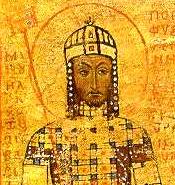Portal:Middle Ages
The Middle Ages portal
The Middle Ages, or medieval period, spanned roughly from 500 to 1500 AD and traditionally represents the central chapter of European history, bridging classical antiquity and the modern era. This era is traditionally divided into the early, high, and late Middle Ages, with each period marking significant changes in social structure, economy, and political power. The period saw agriculture as the primary economic force, a society built on intrapersonal power relations, and a decentralised system of government with limited administrative reach.
Prior to the early Middle Ages, Western Europe experienced the decline of centralised Roman authority and the beginning of Germanic tribal migrations, leading to the fall of the Western Roman Empire. This transition period, sometimes called the Dark Ages, saw the establishment of new kingdoms, a reduced tax system, and land-based military financing. The Eastern Roman Empire, also known as the Byzantine Empire, remained although it lost significant territories to Early Muslim conquests. By the 9th century, the Carolingian Empire briefly unified parts of Western Europe before breaking into fragmented, competitive states.
The high Middle Ages, from 1000 onward, were characterized by population growth, agricultural innovation, and economic expansion. Feudalism emerged as a dominant social structure, with knights serving lords in exchange for land. The Catholic Church grew in authority, but it faced conflicts with secular rulers over control. Scholasticism and the establishment of universities fostered new intellectual pursuits, while architectural innovations in Romanesque and Gothic architecture flourished. However, the Late Middle Ages brought challenges, including famine, the Black Death, and the Hundred Years' War, which led to social upheaval and significant population decline. By the end of this period, Renaissance ideas began to emerge, setting the stage for the Age of Discovery. (Full article...)
Selected article
Selected biography

Manuel I Komnenos (or Comnenus) (Greek: Μανουήλ Α' Κομνηνός, Manouēl I Komnēnos) (28 November 1118 – 24 September 1180) was a Byzantine Emperor of the 12th century who reigned over a crucial turning point in the history of Byzantium and the Mediterranean.
Eager to restore his empire to its past glories as the superpower of the Mediterranean world, Manuel pursued an energetic and ambitious foreign policy. In the process he made alliances with the Pope and the resurgent west, invaded Sicily, successfully handled the passage of the dangerous Second Crusade through his empire, and established a Byzantine protectorate over the Crusader states of Outremer. Facing Muslim advances in the Holy Land, he made common cause with the Kingdom of Jerusalem and participated in a combined invasion of Fatimid Egypt. Manuel reshaped the political maps of the Balkans and the eastern Mediterranean, placing the kingdoms of Hungary and Outremer under Byzantine hegemony and campaigning aggressively against his neighbours both in the west and in the east. However, towards the end of his reign Manuel's achievements in the east were compromised by a serious defeat at Myriokephalon, which in large part resulted from his arrogance in attacking a well-defended Seljuk position. Although the Byzantines recovered and Manuel concluded an advantageous peace with Sultan Kilij Arslan II, Myriokephalon proved to be the final, unsuccessful effort by the empire to recover the interior of Anatolia from the Turks. (read more . . . )
Did you know...
- ...that a paillasse is a thin mattress filled with hay or sawdust and was commonly used in the middle ages?
- ...that a barbican is a tower or other fortification defending the drawbridge, usually the gateway?
- ...that a coif is a type of armored head-covering made out of chain-mail and worn under the helmet for extra protection?
- ...that a heriot is a payment owed to the lord of the manor by a serf’s family upon the serf’s death; usually the family’s best animal, such as a cow, horse or most commonly ox?
- ...that before 1066, it was noted in the Domesday Book, if one Welshman killed another, the dead man’s relatives could exact retribution on the killer and his family (even burning their houses) until burial of the victim the next day?
- ...that buboes are pus-filled egg-sized swellings of the lymph glands of the neck, armpits, and groin; typically found in cases of bubonic plague?
- ...that laws passed in the late 1300s aimed at maintaining class distinctions by prohibiting lower classes from dressing as if they belonged to higher classes?
- ...that Pier Gerlofs Donia, a 15th century Frisian freedom fighter of 7 feet tall was alleged to be so strong that he could lift a 1000 pound horse?
- ...that Edgar Ætheling was the last of the Anglo-Saxon Kings of England, but was only proclaimed, never crowned?
Selected image
 |
The Song of Roland is the oldest major work of French literature. It exists in various different manuscript versions, which testify to its enormous and enduring popularity in the 12th to 14th centuries.
Related portals
Subcategories
Topics
Medieval Armenia · History of Bosnia and Herzegovina (958–1463) · Bulgarian Empire · Britain in the Middle Ages · Byzantine Empire · Medieval Croatian state · Crusader states · History of the Czech lands in the Middle Ages · England in the Middle Ages · France in the Middle Ages · Germany in the Middle Ages · Italy in the Middle Ages · Kievan Rus′ · Poland in the Middle Ages · Portugal in the Middle Ages ·Romania in the Middle Ages · Scotland in the High Middle Ages · History of Medieval Serbia · Spain in the Middle Ages · Women in the Middle Ages · Kingdom of Hungary in the Middle Ages · Wales in the Middle Ages
Things you can do
 |
Here are some tasks awaiting attention:
|
WikiProjects
Associated Wikimedia
The following Wikimedia Foundation sister projects provide more on this subject:
-
Commons
Free media repository -
Wikibooks
Free textbooks and manuals -
Wikidata
Free knowledge base -
Wikinews
Free-content news -
Wikiquote
Collection of quotations -
Wikisource
Free-content library -
Wikiversity
Free learning tools -
Wiktionary
Dictionary and thesaurus










